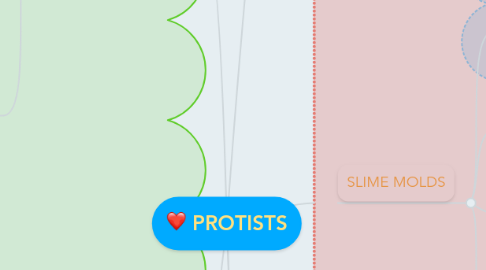
1. marphology
1.1. plasma membrane = multicellular plant/animal
1.2. cytoplasm
1.2.1. outer
1.2.2. inner
1.3. pellicle structure
1.4. vacuole
1.4.1. contractile
1.4.2. phagocytic
1.5. energy production
1.5.1. mitochondria
1.5.2. chloroplast
1.5.3. hydrogenosomes
1.6. cilia/flagella - motility
1.7. asexual/sexual reproduction
2. PROTOZOA
2.1. unicellular, eukaryotic animal-like protists
2.2. predatory/parasitic
2.3. aerobic/anaerobic
2.4. colourless & motile
2.5. asexual & sexual
2.6. water & soil
2.7. aerobic heterotrophs & anaerobic
2.8. obtain food :
2.8.1. ingestion
2.8.2. pinocytosis
2.8.3. phagocytosis
2.8.4. absorption
2.9. major group
2.9.1. Archaezoa
2.9.1.1. flagellated
2.9.1.2. move : whiplike manner
2.9.1.3. free-living
2.9.1.4. parasitic/pathogenic
2.9.1.5. freshwater
2.9.2. Rhizopoda
2.9.2.1. amoebas
2.9.2.2. move : pseudopods
2.9.2.3. food - phagocytosis
2.9.2.4. freshwater / marine
2.9.3. Ciliophora
2.9.3.1. possess cilia
2.9.3.2. nuclei
2.9.3.2.1. micronucleus
2.9.3.2.2. macronucleus
2.9.3.3. gullet/cytosome
2.9.3.4. freshwater/marine
2.9.4. Apicomplexa
2.9.4.1. not motile in mature
2.9.4.2. obligate parasites
2.9.4.3. complex life cycle
2.9.4.4. animal parasites
3. nutrition
3.1. mixotrophic protists
3.2. photoautrophic
3.3. protozoa - chemoheterotrophic
4. distribution
4.1. eukaryotes
4.2. unicellular
4.3. moist habitat
4.4. parasitis form
5. ALGAE
5.1. characteristics
5.1.1. simple morphological construction
5.1.2. asexual
5.1.2.1. fragmentation
5.1.2.2. spores
5.1.2.3. binary fission
5.1.3. sexual
5.1.4. photoautotrophic
5.1.5. freshwater / marine / moist soils / few dry soils / acidic habitat
5.1.6. can be unicellular
5.1.7. cell wall : chitin / silica
5.1.8. motile
5.1.8.1. single flagella - Euglena
5.1.8.2. 2 @ 4 polar flagella - Chlorophyta
5.2. distribution
5.2.1. primarily aquatic
5.2.1.1. Planktonic
5.2.1.2. Benthic
5.2.1.3. Neustonic
5.2.2. terrestrial
5.3. Ecology
5.3.1. seaweed
5.3.2. human food
5.3.3. secondary product
5.3.4. macroscopic form
5.3.5. primary producers - ocean
5.4. Taxonomy
5.4.1. Chlorophyta
5.4.1.1. green algae
5.4.1.2. cellulose cell wall
5.4.1.3. uni / multicellular
5.4.1.4. chlorophyll a & b
5.4.1.5. store glucose polymer
5.4.2. Rhodophyta
5.4.2.1. reddish
5.4.2.2. multicellular
5.4.2.3. cell wall - cellulose
5.4.2.4. sexual
5.4.2.5. habitat - marine
5.4.3. Phaeophyta
5.4.3.1. brownish
5.4.3.2. macroscopic
5.4.3.3. muticellular
5.4.3.4. cellulose/algin - cell wall
5.4.3.5. sexual
5.4.3.6. storage - carbohydrate
5.4.3.7. habitat-marine
5.4.4. Chrysophyta
5.4.4.1. golden-brown
5.4.4.2. chlorophyll a & c
5.4.4.3. unicellular
5.4.4.4. cell wall-peptin & silica
5.4.4.5. sexual
5.4.4.6. storage - oil
5.4.4.7. freshwater, marine, soil
5.4.5. Pyrrophyta
5.4.5.1. unicellular
5.4.5.2. brownish
5.4.5.3. produce neurotoxins
5.4.5.4. chlorophyll a & c
5.4.5.5. cell wall - cellulose
5.4.5.6. storage - starch
5.4.5.7. freshwater, marine
5.4.6. Euglenophyta
5.4.6.1. unicellular
5.4.6.2. green
5.4.6.3. no cell wall
5.4.6.4. pellicle
5.4.6.5. no sexual
5.4.6.6. storage - glucose polymer
5.4.6.7. freshwater, marine
6. SLIME MOLDS
6.1. Myxomycota
6.1.1. plasmodial
6.1.2. saprophytes
6.1.3. multinucleated
6.1.4. motile - plasmodium
6.2. Acrasioycota
6.2.1. cellular
6.2.2. feed phagocytically
6.3. Peronosporomycetes
6.3.1. water
6.3.2. no chitin in cell wall
6.3.3. some parasites of fish gills
6.4. Distribution & function
6.4.1. moist terrestrial habitat
6.4.2. engulf bacteria
6.4.3. as decomposer & consumer
6.4.4. recycling of nutrients
6.4.5. cause diseases in plants
